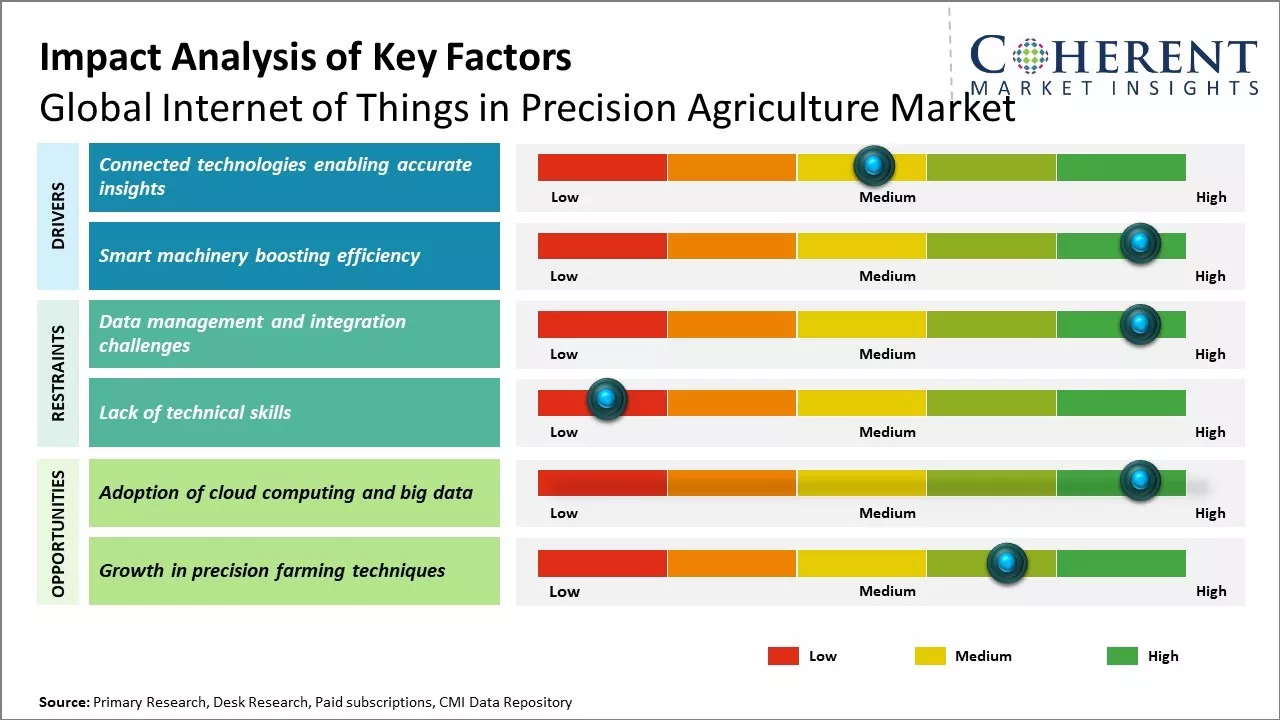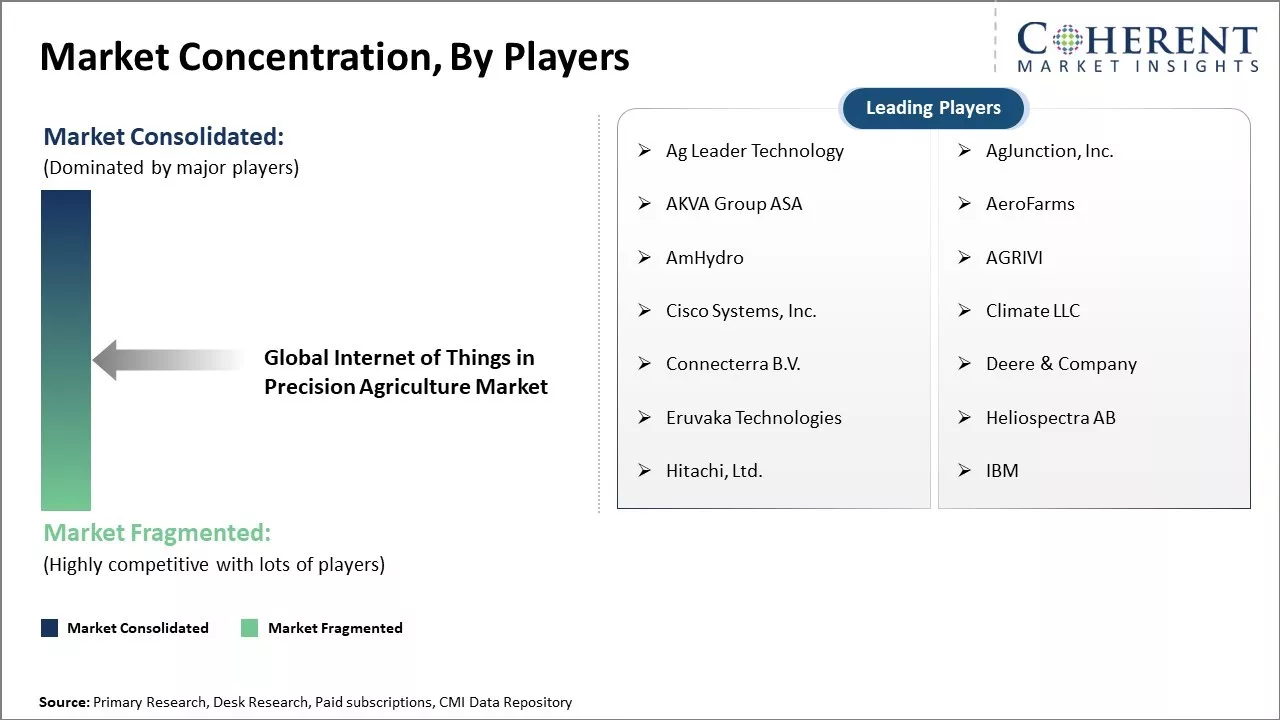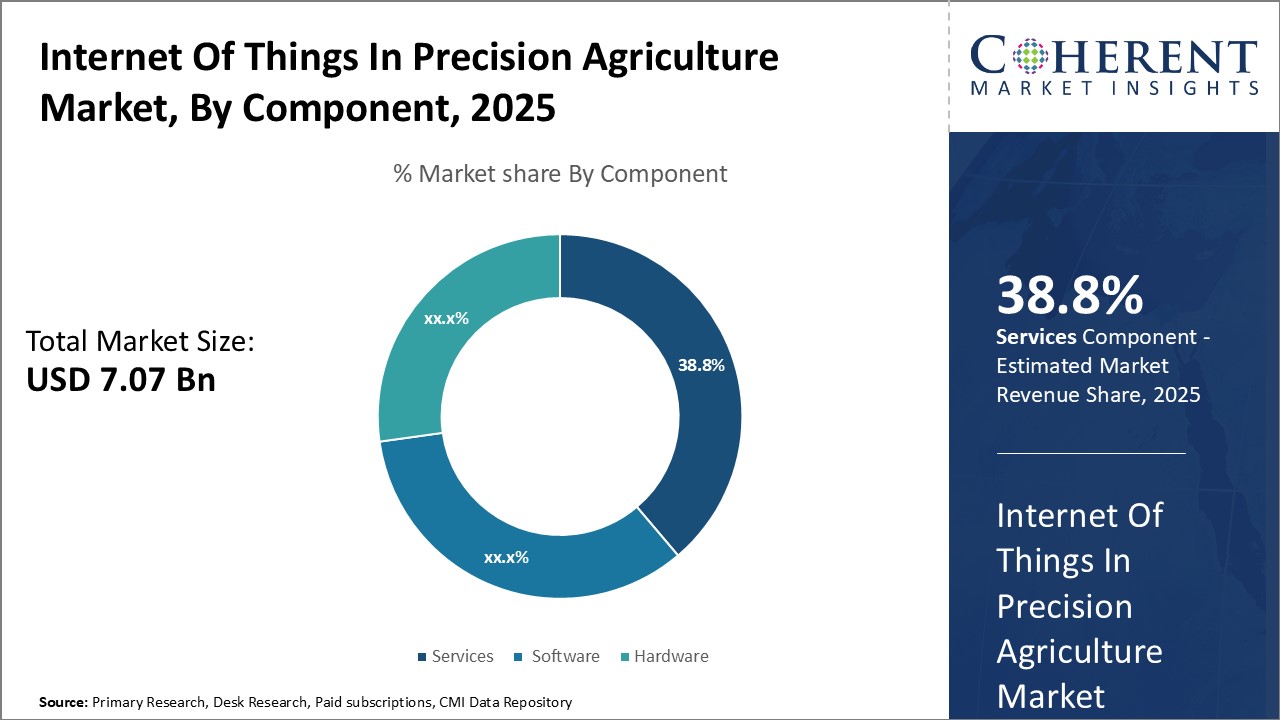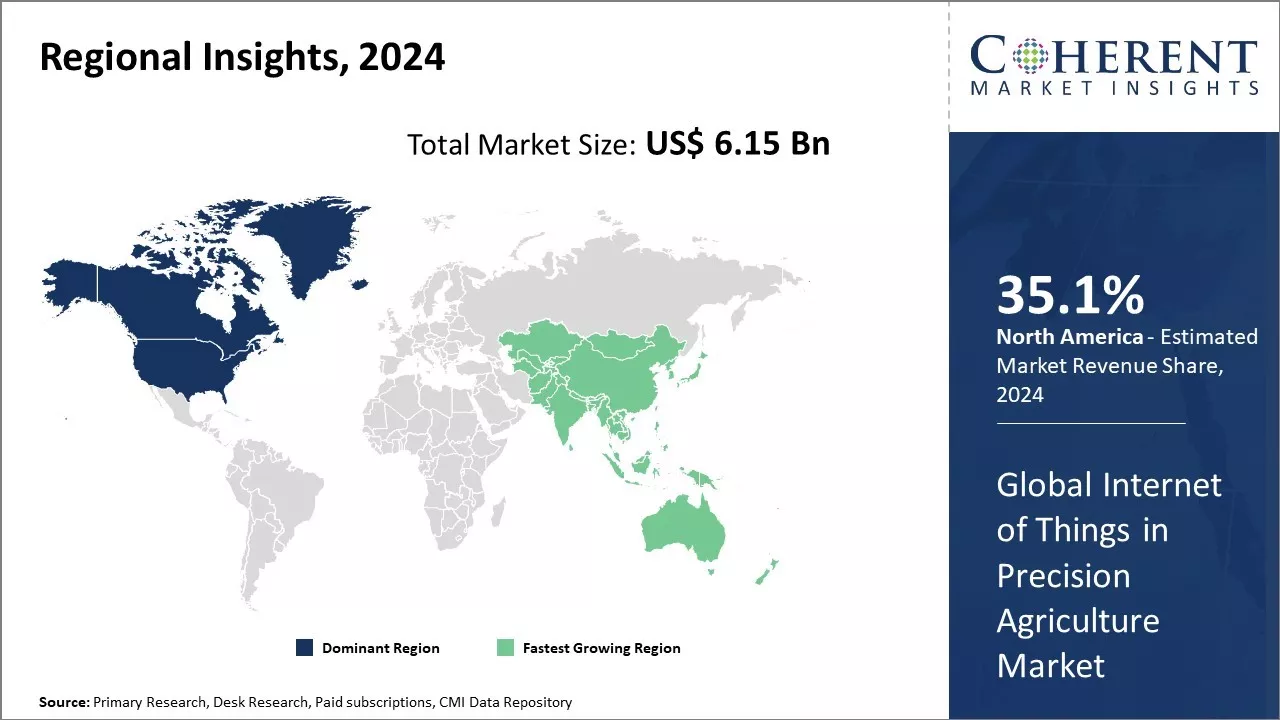
Global Internet of Things in precision agriculture market is estimated to be valued at US$ 7.07 Bn in 2025 and is expected to reach US$ 18.83 Bn by 2032, exhibiting a compound annual growth rate (CAGR) of 15.0% from 2025 to 2032.

Discover market dynamics shaping the industry: Download Free Sample
IoT coupled with machine learning and artificial intelligence has helped farmers gain real-time insights about soil and climate conditions. This has enabled them to boost productivity and optimize resource utilization through precision agriculture techniques.
The market growth is driven by need for optimum use of resources and real-time monitoring of crops. Deployment of IoT sensors, drones and other smart devices allow farmers to remotely collect data related to moisture, temperature and fertility of soil. Analytics tools further help in yield estimation and produce grading. Rising requirement for food due to increasing global population can boosts need for precision agriculture and corresponding internet of things solutions globally.
Connected technologies enabling accurate insights
The ability of connected devices and technologies to generate accurate insights can drive the Internet of Things in precision agriculture market growth. Precision agriculture utilizes various technologies and devices such as sensors, GPS systems, drones and other equipment to collect vital field data. This data when combined with advanced analytics and IoT capabilities can provide actionable insights to farmers. Parameters such as soil moisture levels, ambient temperature, nutrient levels, and insect population that impact yield can be continuously monitored through connected sensors. Technologies like drones equipped with advanced cameras and sensors allow capture of field images at high resolutions. Image analytics helps identify issues such as diseases and insect attacks at an early stage when remedy is most effective.
The seamless connectivity between various devices and tools by IoT enables compiling field data from diverse sources into a unified platform. This big data when analyzed using techniques like predictive modeling, prescriptive actions and advanced forecasting generates robust insights. Thus, farmers can make well-informed decisions regarding optimal seed varieties, quantity of fertilizers and pesticides required, irrigation schedules and other farm operations. It helps to achieve higher yields while minimizing costs and wastage of resources. The insights also assist in planning and taking precautionary measures well in advance based on predicted weather patterns and their impact.

Get actionable strategies to beat competition: Download Free Sample
Smart machinery boosting efficiency
Increased adoption of smart machinery can drive the market growth. Modern agricultural equipment is increasingly being integrated with advanced technologies that improve functionality and boost efficiency of operations. Machines are being outfitted with auto-steering systems, sensors, cameras, controls and other IoT capabilities. For example, smart tractors come equipped with GPS, telemetry sensors as well as auto-control of implements to autonomously navigate fields according to programmed work patterns. Sensors send real-time data about performance of different parts to the cloud for monitoring and preventive maintenance.
Smart sprayers contain sensors and cameras to detect crop density and health status in real-time. The sprayers then automatically adjust the dosage and droplet size of pesticides and fertilizers as required during spraying cycles.
Key Takeaways from Analyst:
Rising use of IoT technologies enable farmers to optimize productivity and enhance crop yields. Various sensors embedded in farm equipment, greenhouses are helping farmers to remotely monitor soil, greenhouse conditions and animal health. This data collection and analysis allows for more proactive management of farms. North America currently dominates the market due to widespread adoption of advanced technologies among large farms in the region. However, Asia Pacific is expected to emerge as the fastest growing market due to presence of large agricultural sector and increasing government support for smart farming practices.
Increasing digital transformation on farms can drive the market growth, however, high initial investment costs can hamper the adoption of IoT solutions, especially for smaller farms with tighter budgets. Lack of proper IoT and data analytics skills hampers operational efficiency for some users. However, new low-cost IoT devices and the development of user-friendly applications can address these restraints. Market players are also focusing on developing customized solutions targeted for specific crop and livestock types to further encourage adoption.
Market Challenges: Data management and integration challenges
Data management and integration pose significant challenges for the growth of the global Internet of Things (IoT) in precision agriculture. With the increasing number of IoT devices on farms, vast amounts of data are generated in real-time from diverse sources like sensors, drones, and autonomous machinery. This data varies widely in format—structured, unstructured, and semi-structured—and often adheres to different standards, complicating its consolidation and analysis. Additionally, the absence of universal data transfer protocols for these heterogeneous devices obstructs seamless integration.
Market Opportunities: Adoption of cloud computing and big data
Cloud computing and big data present a major opportunity for global Internet of Things in precision agriculture market growth. As more agricultural operations adopt networked sensors to monitor everything from soil moisture and plant health to climate conditions and equipment usage, there has been increase in amount of data being generated. Storing, processing, and deriving insights from this volume of data requires scalable infrastructure and advanced analytical capabilities.
Farmers can leverage cloud-based solutions to cost-effectively collect sensor readings from widely distributed fields, process and analyze the data using machine learning models, and gain actionable insights without needing to make sizable capital investments in on-premise IT infrastructure that requires constant maintenance and upgrades. The cloud's flexibility enables scaling computing and storage resources up or down depending on seasonal demands. Data from multiple farms can also be aggregated and mined in the cloud to develop optimized strategies.

Discover high revenue pocket segments and roadmap to it: Download Free Sample
Insights By Component- Reliance on professional expertise drives services segment growth
The Services segment is anticipated to capture a 38.8% share of the precision agriculture market in 2025, reflecting its essential role in addressing the complexities and customization needs of precision agriculture. While precision agriculture utilizes various technologies for optimized farm management, effective integration and implementation require specialized knowledge and expertise. The involvement of diverse hardware and software components from multiple vendors necessitates consultation, integration, maintenance, and technical support services, typically provided by agricultural professionals and technology specialists. Given the variability in farm landscapes, soil conditions, and crops, tailored solutions are crucial, as a one-size-fits-all approach may not achieve optimal results. These services enable farmers to maximize their returns on investments in precision agriculture technologies by ensuring that the unique needs of individual farms are met and that data is transformed into actionable insights for better decision-making. Additionally, ongoing training and advisory services are vital due to the continuous emergence of new techniques and technologies. This reliance on specialized skills and knowledge positions services as the leading component driving the adoption of precision agriculture.
Insights By System- Monitoring capabilities fuel sensing system prominence
The Sensing System segment is projected to dominate the precision agriculture market with a 40.1% share in 2025, primarily due to its critical role in data collection. Precision agriculture relies on systematic monitoring of farm variables to gain operational insights. Sensing systems equipped with sensors, drones, cameras, and other devices enable round-the-clock field surveillance without human intervention. These systems track above-ground factors like crop health, yield, and pest infestation, as well as below-ground attributes such as moisture levels, soil conditions, and nutrient deficiencies. Technologies like sensor fusion and the Internet of Things (IoT) allow these systems to simultaneously gauge multiple parameters and transmit real-time analytics. This comprehensive monitoring capability facilitates timely decision-making on irrigation, fertilization, spraying, and other management practices. It also aids in benchmarking performance and optimizing input usage for higher productivity and long-term economic benefits. As high-quality data acquisition is pivotal to the success of precision agriculture initiatives, sensing systems remain the most crucial system segment.
Insights By Application- Weather Tracking pivotal for decision support
The Weather Tracking and Forecasting segment is projected to dominate the market with a share of 42.4% in 2025, primarily due to agriculture's reliance on weather conditions. Variations in climate and rainfall significantly affect crop yields, and unpredictable weather events such as droughts, floods, and frost can devastate harvests, threatening farm incomes. Precision agriculture enhances weather monitoring and forecasting tailored to specific micro-climates, enabling farmers to observe weather patterns, advisories, and long-term forecasts closely. This information is crucial for determining optimal sowing times, predicting water needs, scheduling spraying and harvesting, and issuing timely alerts. Additionally, historical weather data is instrumental in assessing insurance risks. Enhanced weather tracking further optimizes the use of agricultural resources, including labor and machinery, in alignment with climatic conditions, leading to better-informed decision-making and reduced losses due to weather unpredictability. This critical role of weather tracking and forecasting solidifies its position as the leading application segment in precision agriculture.

Need a Different Region or Segment? Download Free Sample
North America dominates the global Internet of Things in precision agriculture market. The region is expected to account for highest market share of 35.6% in 2025, owing to strong presence of key industry players and early adoption of latest technologies in the region. The U.S. accounts for the major share due to large-scale smart farming and growing emphasis on improving crop quality and maximizing yields. Several field trials and pilots of IoT solutions for agriculture have been successful in the U.S., driving its large-scale commercialization. Furthermore, supportive government initiatives and policies boost technological innovation.
Europe is another major regional market led by countries such as Germany, France and the U.K. Integrated supply chain networks, availability of skilled workforce and focus toward sustainable practices support the rapid deployment of IoT systems across farms. Moreover, growing exports of food and crops has propelled European nations to adopt smart agriculture practices for ensuring superior yields. The exchange of knowledge and expertise between academic institutes and technology providers further stimulates the development of intuitive IoT platforms. The incentives for new product development and government programs for the adoption of advanced agriculture techniques can drive the market growth.
Asia Pacific exhibits the fastest growth and is emerging as a lucrative regional Internet of Things in precision agriculture market. Countries like China, India, Japan and South Korea are increasingly investing in mechanization and automated systems to boost productivity and meet the rising food demand. The progressive economies offer opportunities for market players to collaborate with local partners and establish manufacturing bases. Improving internet connectivity in rural regions and initiatives such as ‘Digital India’ and ‘Precision Farming Development’ can foster the deployment of IoT infrastructure. This paves opportunities for solution providers to design low-cost and scalable platforms tailored for the diverse crop patterns and agricultural practices of Asia Pacific.
Internet Of Things In Precision Agriculture Market Report Coverage
| Report Coverage | Details | ||
|---|---|---|---|
| Base Year: | 2024 | Market Size in 2025: | USD 7.07 Bn |
| Historical Data for: | 2020 To 2024 | Forecast Period: | 2025 To 2032 |
| Forecast Period 2025 to 2032 CAGR: | 15.0% | 2032 Value Projection: | USD 18.83 Bn |
| Geographies covered: |
|
||
| Segments covered: |
|
||
| Companies covered: |
Ag Leader Technology, AgJunction, Inc., AKVA Group ASA, AeroFarms, AmHydro, AGRIVI, Cisco Systems, Inc., Climate LLC, Connecterra B.V., Deere & Company, Eruvaka Technologies, Heliospectra AB, Hitachi, Ltd., IBM |
||
| Growth Drivers: |
|
||
| Restraints & Challenges: |
|
||
Uncover macros and micros vetted on 75+ parameters: Get instant access to report
*Definition: Global Internet of Things in Precision Agriculture Market refers to the application of IoT technologies in precision agriculture. It involves connecting agricultural infrastructure like irrigation systems, soil sensors, greenhouse equipment to the internet to monitor crop growth conditions, soil moisture levels, and temperaturemake informed decisions about irrigation, pesticides and fertilizers. This helps farmers optimize crop yields and harvests through remote monitoring and precise application of inputs based on real-time data analysis. IoT in Precision Agriculture improve farm productivity globally.
Share
Share
About Author
Ankur Rai is a Research Consultant with over 5 years of experience in handling consulting and syndicated reports across diverse sectors. He manages consulting and market research projects centered on go-to-market strategy, opportunity analysis, competitive landscape, and market size estimation and forecasting. He also advises clients on identifying and targeting absolute opportunities to penetrate untapped markets.
Missing comfort of reading report in your local language? Find your preferred language :
Transform your Strategy with Exclusive Trending Reports :
Frequently Asked Questions
Joining thousands of companies around the world committed to making the Excellent Business Solutions.
View All Our Clients